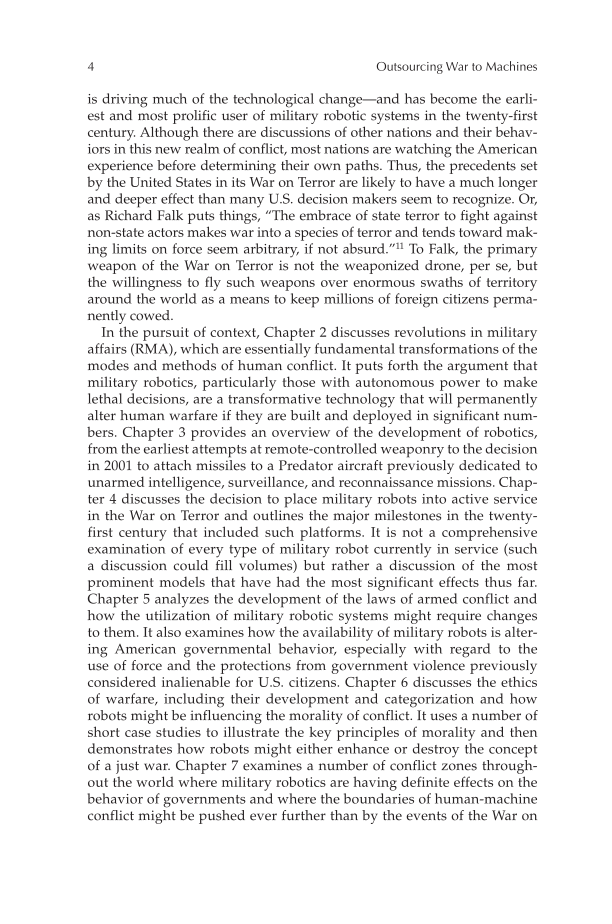4 Outsourcing War to Machines is driving much of the technological change—and has become the earli- est and most prolific user of military robotic systems in the twenty-first century. Although there are discussions of other nations and their behav- iors in this new realm of conflict, most nations are watching the American experience before determining their own paths. Thus, the precedents set by the United States in its War on Terror are likely to have a much longer and deeper effect than many U.S. decision makers seem to recognize. Or, as Richard Falk puts things, “The embrace of state terror to fight against non-state actors makes war into a species of terror and tends toward mak- ing limits on force seem arbitrary, if not absurd.”11 To Falk, the primary weapon of the War on Terror is not the weaponized drone, per se, but the willingness to fly such weapons over enormous swaths of territory around the world as a means to keep millions of foreign citizens perma- nently cowed. In the pursuit of context, Chapter 2 discusses revolutions in military affairs (RMA), which are essentially fundamental transformations of the modes and methods of human conflict. It puts forth the argument that military robotics, particularly those with autonomous power to make lethal decisions, are a transformative technology that will permanently alter human warfare if they are built and deployed in significant num- bers. Chapter 3 provides an overview of the development of robotics, from the earliest attempts at remote-controlled weaponry to the decision in 2001 to attach missiles to a Predator aircraft previously dedicated to unarmed intelligence, surveillance, and reconnaissance missions. Chap- ter 4 discusses the decision to place military robots into active service in the War on Terror and outlines the major milestones in the twenty- first century that included such platforms. It is not a comprehensive examination of every type of military robot currently in service (such a discussion could fill volumes) but rather a discussion of the most prominent models that have had the most significant effects thus far. Chapter 5 analyzes the development of the laws of armed conflict and how the utilization of military robotic systems might require changes to them. It also examines how the availability of military robots is alter- ing American governmental behavior, especially with regard to the use of force and the protections from government violence previously considered inalienable for U.S. citizens. Chapter 6 discusses the ethics of warfare, including their development and categorization and how robots might be influencing the morality of conflict. It uses a number of short case studies to illustrate the key principles of morality and then demonstrates how robots might either enhance or destroy the concept of a just war. Chapter 7 examines a number of conflict zones through- out the world where military robotics are having definite effects on the behavior of governments and where the boundaries of human-machine conflict might be pushed ever further than by the events of the War on
Document Details My Account Print multiple pages
Print
You have printed 0 times in the last 24 hours.
Your print count will reset on at .
You may print 0 more time(s) before then.
You may print a maximum of 0 pages at a time.
























































































































































































































































































